The Port of Kobe is one of Japan's largest and most significant international ports, situated on the northern shore of Osaka Bay on the main island of Honshu. With a long and rich history as a maritime gateway, it serves as a key commercial and passenger hub for the entire Kansai region.
The port is renowned for its scenic setting, nestled between the Rokko Mountains and the sea. After being heavily damaged in the 1995 Great Hanshin earthquake, it was rebuilt into a modern and highly efficient facility. For cruise passengers, Kobe is a popular port of call offering sophisticated urban attractions and easy access to the historic cities of Kyoto and Osaka.
Kobe offers a variety of attractions easily accessible within a port day. A must-see is the historic Kitano-chō district, where former foreign merchants' mansions (Ijinkan) are preserved on a scenic hillside, about a 15-minute taxi or bus ride from the city center.
For breathtaking views, take a trip up the Shin-Kobe Ropeway to the Kobe Nunobiki Herb Gardens, which offers a stunning panorama of the city and bay. Another popular destination for panoramic views is Mount Rokkō, accessible via a scenic cable car ride.
The waterfront Kobe Harborland area, close to the port, is a bustling entertainment district with shopping malls, restaurants, and a landmark Ferris wheel. For a relaxing experience, consider a visit to Arima Onsen, one of Japan's oldest hot spring towns, located within the city limits and reachable in about 45 minutes.
Last updated on June 20, 2025
Kobe's location in the Kansai region makes it an excellent base for exploring nearby cities. Osaka, known for its vibrant food scene and the historic Osaka Castle, is just a 30-40 minute train ride away.
The former imperial capital of Kyoto is also a popular day trip, reachable in about 60-90 minutes by train. There, visitors can explore countless temples, shrines, and the famous Gion geisha district.
For a truly spectacular sight, the city of Himeji is home to the magnificent Himeji Castle, a UNESCO World Heritage site. It can be reached in approximately 30-40 minutes via the Shinkansen (bullet train) or about an hour on a local express train.
Last updated on June 20, 2025
The Kobe Port Terminal is typically located on Port Island, a man-made island in Osaka Bay. It is situated approximately 2-3 kilometers (about 1.5 miles) south of Kobe's central business and transportation hub, the Sannomiya district.
Due to the distance and industrial nature of the immediate port area, walking to the main city sights is not practical. Cruise lines often provide complimentary shuttle buses to Sannomiya Station. Alternatively, passengers can use the highly efficient Port Liner automated train or take a taxi. The terminal building has basic amenities, but more extensive shopping and dining can be found in the city center or the nearby Harborland complex. Cruise ships typically dock directly at the pier, so tendering is uncommon.
Last updated on June 20, 2025
The local currency in Japan is the Japanese Yen (JPY).
US dollars and other foreign currencies are not accepted for general transactions. It is essential to have Yen for purchases at smaller shops, local eateries, and for public transport tickets.
Cruise passengers can find ATMs that accept international cards at post offices and 7-Eleven convenience stores throughout the city. Currency exchange services are available at banks in the city center and at the airport, though rates may be less favorable. Credit cards are widely accepted in department stores, hotels, and larger restaurants in tourist areas.
Last updated on June 20, 2025
Kobe, like the rest of Japan, is considered exceptionally safe with a very low crime rate. Tourists can feel comfortable exploring the city independently, both during the day and at night.
There are no specific areas to avoid, and violent crime is extremely rare. The primary safety concerns are related to natural phenomena; Japan is in a seismically active zone, so being aware of basic earthquake safety is prudent. Standard travel precautions, such as keeping an eye on your belongings in crowded public transport, are always recommended, though theft is not a common issue.
Last updated on June 20, 2025
Kobe has a humid subtropical climate with four distinct seasons. The primary cruise seasons of spring (March-May) and autumn (September-November) offer the most pleasant weather. During these times, temperatures are mild and comfortable, typically ranging from 10°C to 20°C (50°F to 68°F), perfect for sightseeing.
Summers (June-August) are hot and humid, with temperatures often rising above 30°C (86°F) and a rainy season in June and July. Late summer into autumn is also typhoon season, which can occasionally impact port schedules. Visitors should pack layers for spring and fall, and light, breathable clothing for summer. A light raincoat and comfortable walking shoes are recommended year-round.
Last updated on June 20, 2025
Kobe offers an efficient and comprehensive public transportation network. The primary hub for the city is Sannomiya Station, which serves multiple train lines connecting to the rest of the city and region.
To get from the cruise terminal on Port Island to the city center, the most convenient option is the Port Liner, an automated transit system that reaches Sannomiya Station in about 10 minutes. Taxis are also readily available at the terminal; they are clean and reliable but more expensive than public transit. Japan Railways (JR), Hankyu, and Hanshin lines are excellent for reaching nearby cities like Osaka and Himeji.
Last updated on June 20, 2025
Kobe is a fantastic shopping destination with options ranging from sprawling department stores to quaint local shops. The Sannomiya and Motomachi Shopping Streets are extensive covered arcades (shotengai) offering a huge variety of goods. The modern Kobe Harborland complex features the Umie shopping mall with many popular brands and restaurants.
Local specialties to look for include high-quality sake from the nearby Nada-Gogō brewing district, delicate pastries and sweets reflecting the city's international heritage, and Akoya pearls. While Kobe is famous for its Kobe beef, this is primarily a dining experience. Prices are generally fixed, as bargaining is not customary in Japan. Duty-free shopping is available for tourists with a valid passport at designated large stores.
Last updated on June 20, 2025
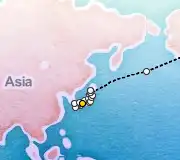
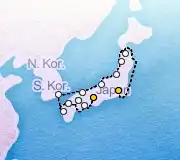
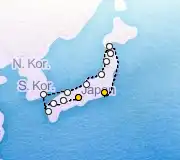
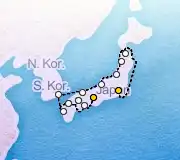
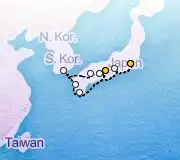

Showing 3 ships in the area
No ships scheduled in port today.
Last updated on June 13, 2025
Taxis are readily available at the cruise terminal, and the Port Liner monorail provides quick access to Sannomiya Station, Kobe's main transport hub. Many waterfront attractions are within walking distance.
Must-see attractions near the port include Meriken Park with the iconic Kobe Port Tower and Maritime Museum, and the Harborland shopping and entertainment complex. The historic Kitano-cho Ijinkan district is a short taxi or bus ride away.
You must try authentic Kobe beef at a local teppanyaki restaurant; Sannomiya and Harborland offer many options. Also sample local sake, as Kobe's Nada district is famous for its breweries.
The local currency is Japanese Yen (1 USD = 143.51 JPY). ATMs that accept international cards can be found at the cruise terminal, 7-Eleven convenience stores, and post offices. Currency exchange is available at banks in Sannomiya or at the airport if flying in/out.
Cruises often visit during spring (April-May) or autumn (Oct-Nov) when weather is mild (15-25°C / 59-77°F); pack layers, comfortable shoes, and an umbrella. Summers are hot and humid, winters are cool.
Suma Beach is a popular sandy beach accessible via a short JR train ride (approx. 15-20 minutes) from Sannomiya Station. It offers good facilities, especially in summer.
Cruise lines offer convenient excursions to Kyoto, Osaka, or Himeji Castle, while independent exploration of Kobe itself is easy via public transport or taxis. Consider your comfort level with independent travel and desired destinations.
Harborland and the Sannomiya and Motomachi shopping arcades offer a wide range of goods from fashion to local crafts. Popular souvenirs include Kobe beef-flavored snacks, local sake, and pearls.
Osaka is a vibrant city about 30 minutes away by train, while the historic city of Kyoto is reachable in about 50 minutes. Himeji Castle, a stunning UNESCO site, is about 30-40 minutes by train.
Kobe was one of Japan's first ports to open to foreign trade in 1868, leading to a rich international influence still visible today. It is also renowned worldwide for its high-quality Kobe beef.
On average Kobe is extremely affordable compared to other ports. Prices are approximately steady throughout the year. Look at the diagram below for the monthly average cost per day.
Want to hear about the best deals and cruise tips every week? Sign up for our free weekly VIP Newsletter, customized exactly to your preferences!